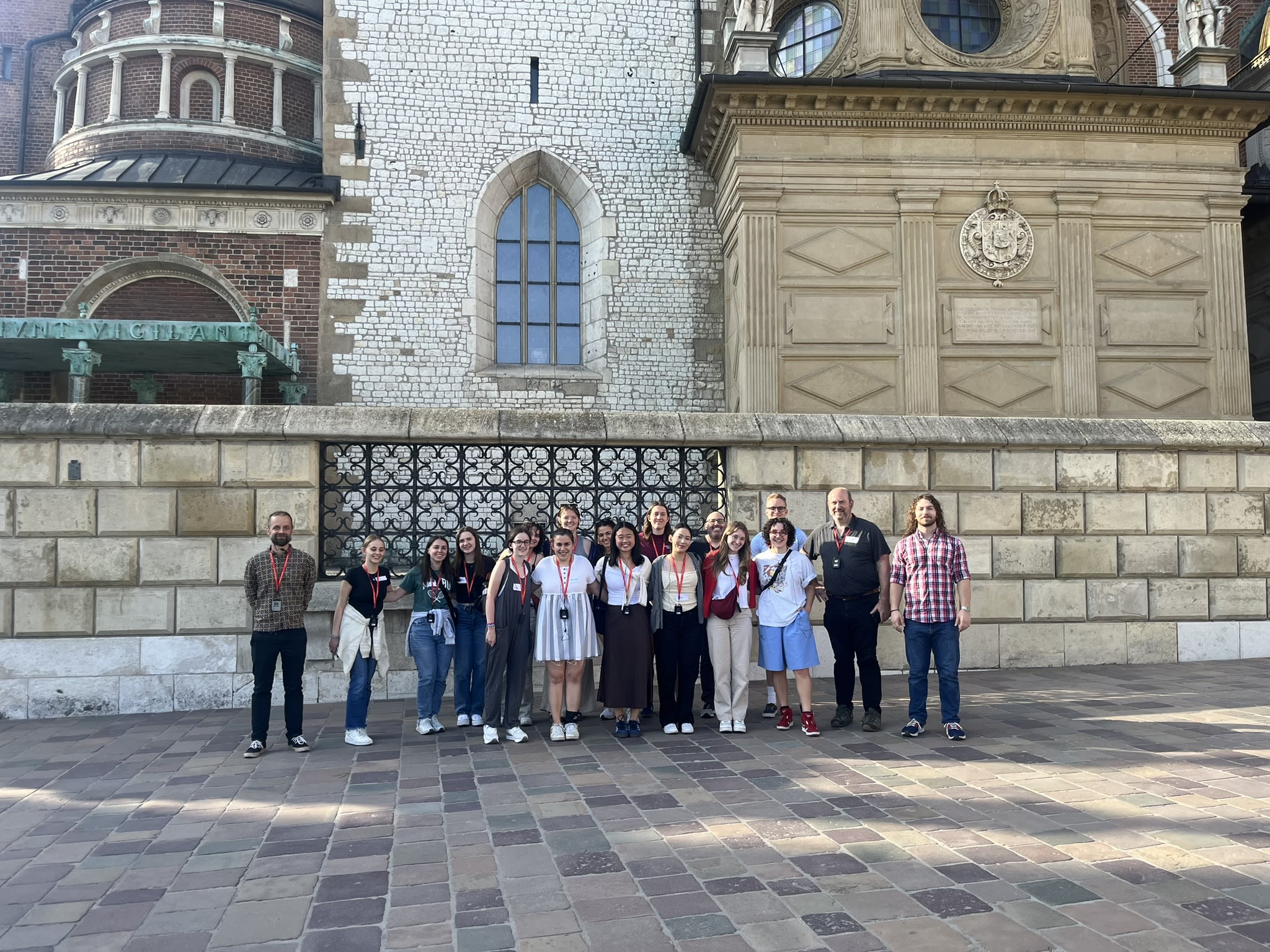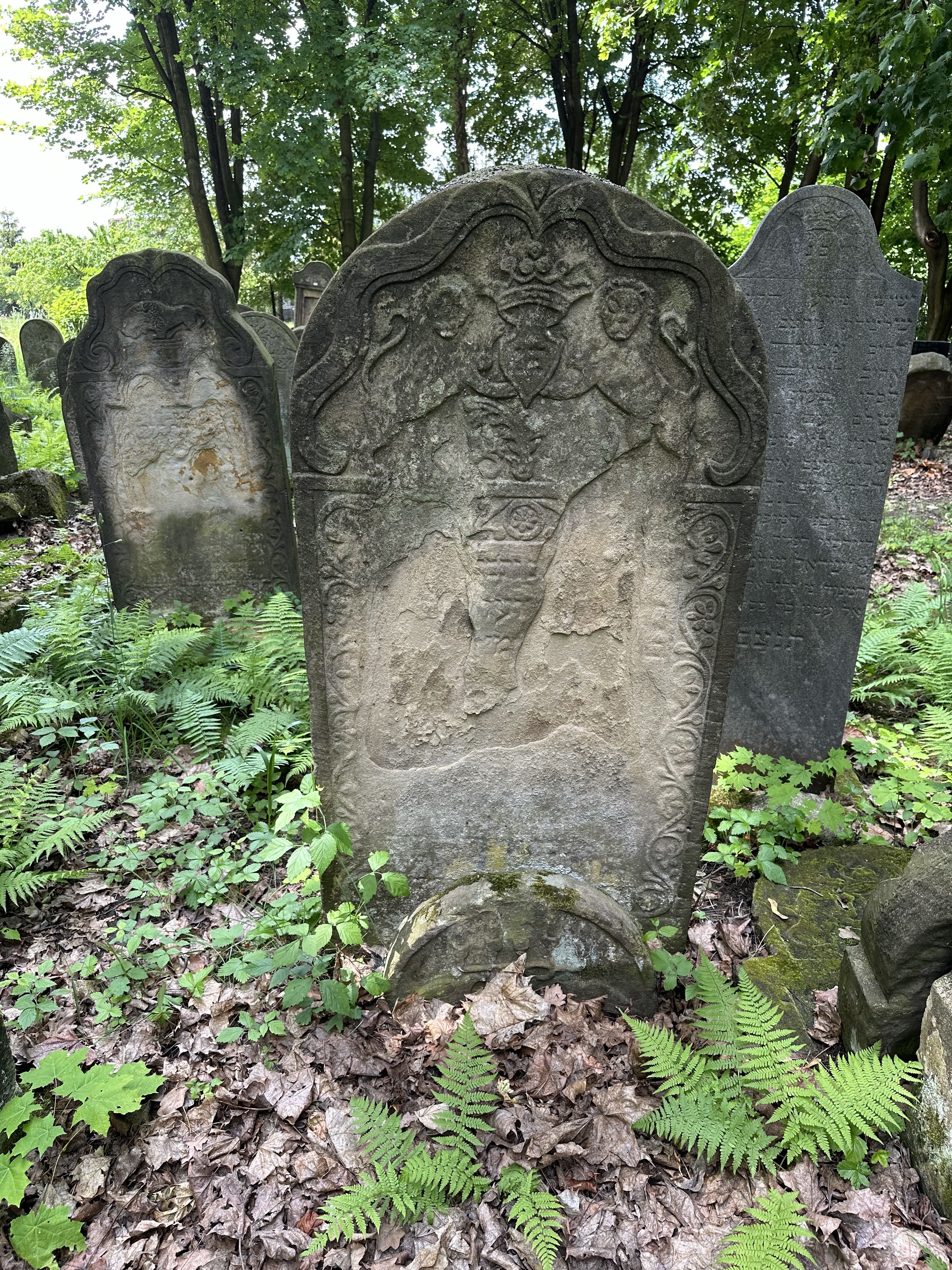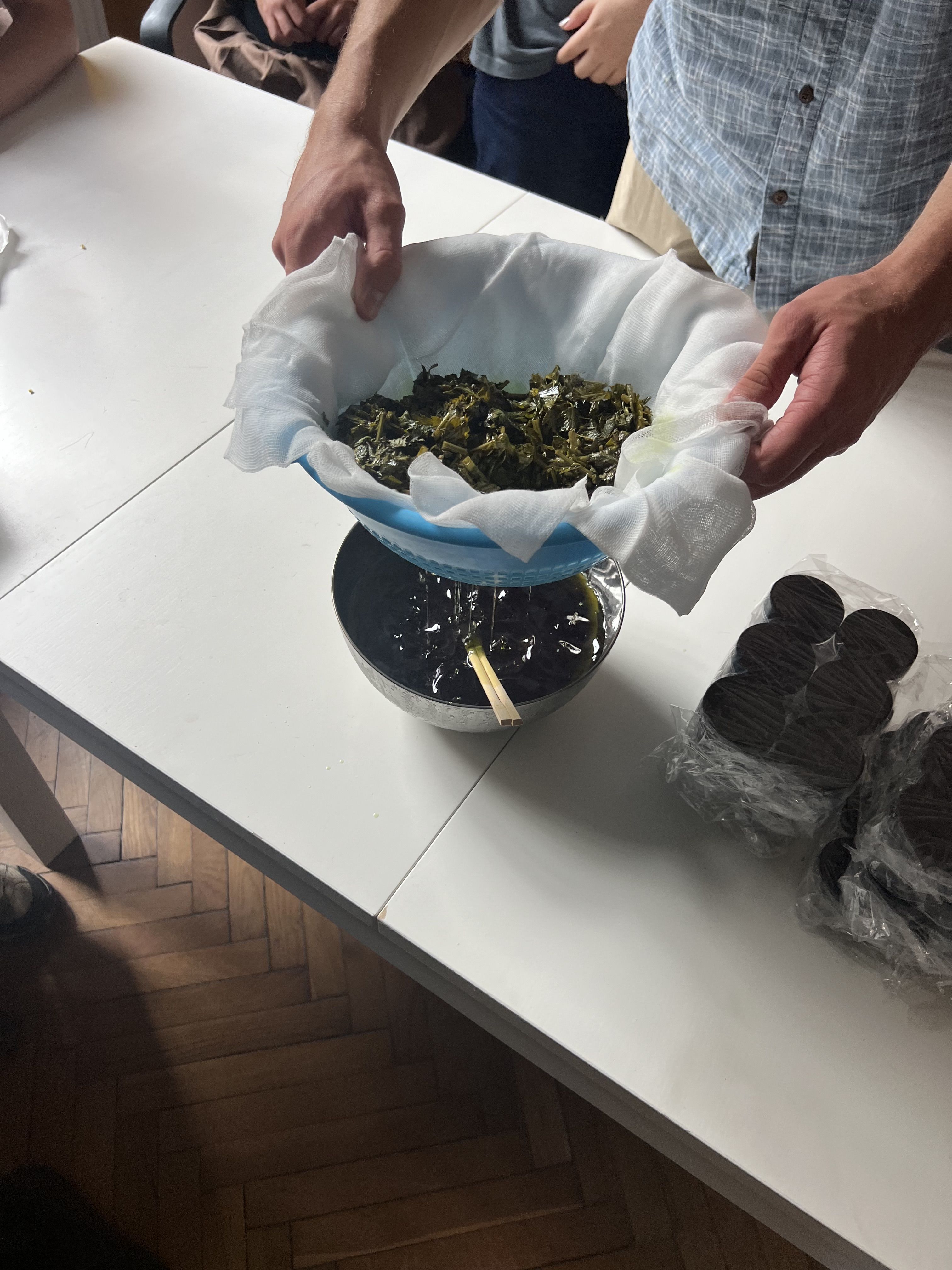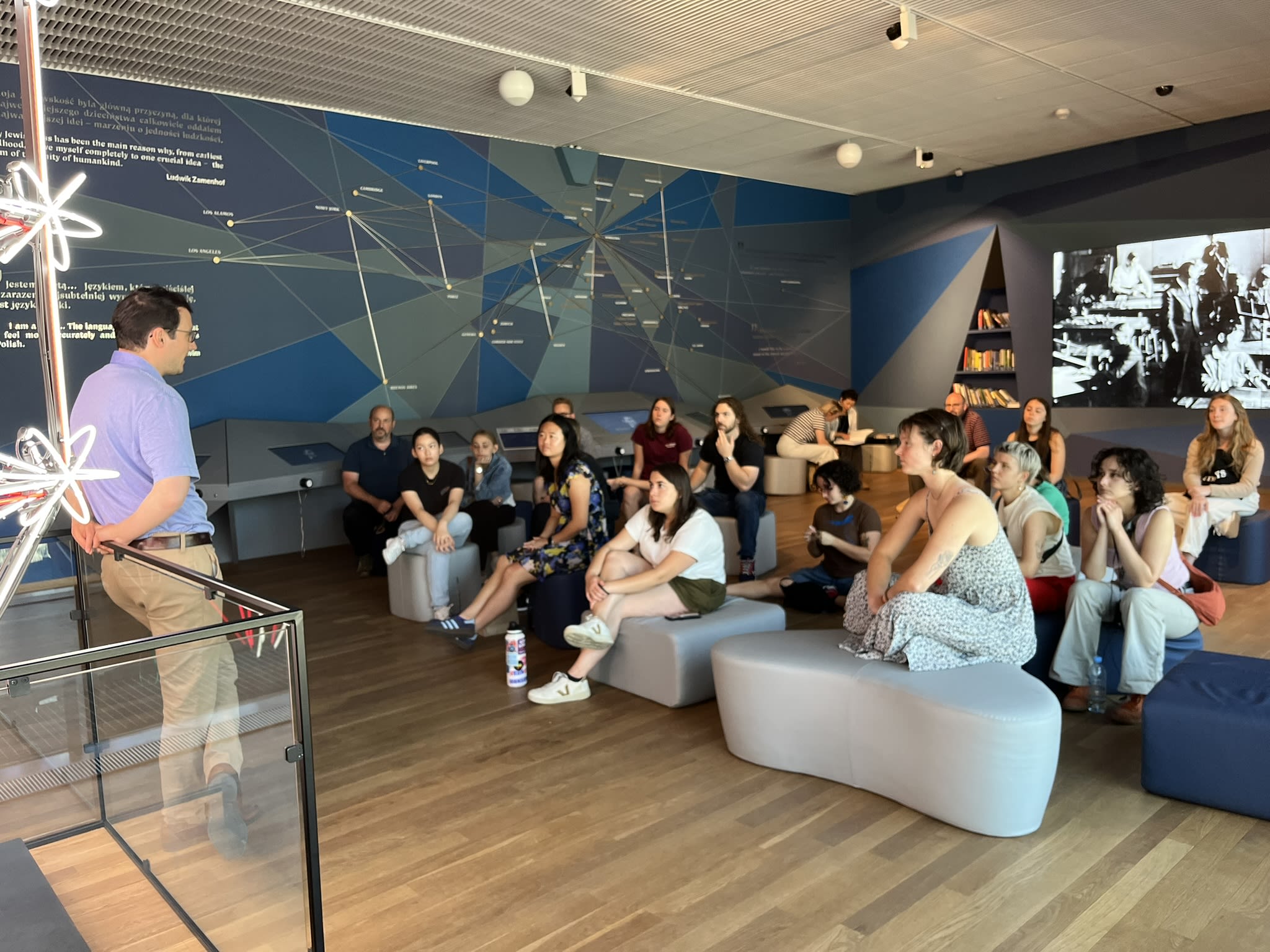Through a trip to Poland, Emory students broaden their knowledge of Jewish history
Susan M. Carini 04G | Oct. 14, 2024
Emory University

The reasons for making the trip were varied, but assessments of its value were unanimous. When 16 tired but exhilarated students stepped off the plane after touchdown in Atlanta, they were abuzz with takeaways from a 10-day trip to Poland sponsored by the Tam Institute for Jewish Studies in partnership with Poland’s Taube Center for Jewish Life and Learning.
Attracting a diverse mix of students — Jewish and non-Jewish, pursuing a range of majors at both Emory College of Arts and Sciences and Oxford College — this trip marked the second year the Tam Institute offered the experience, this time led by Eric Goldstein.
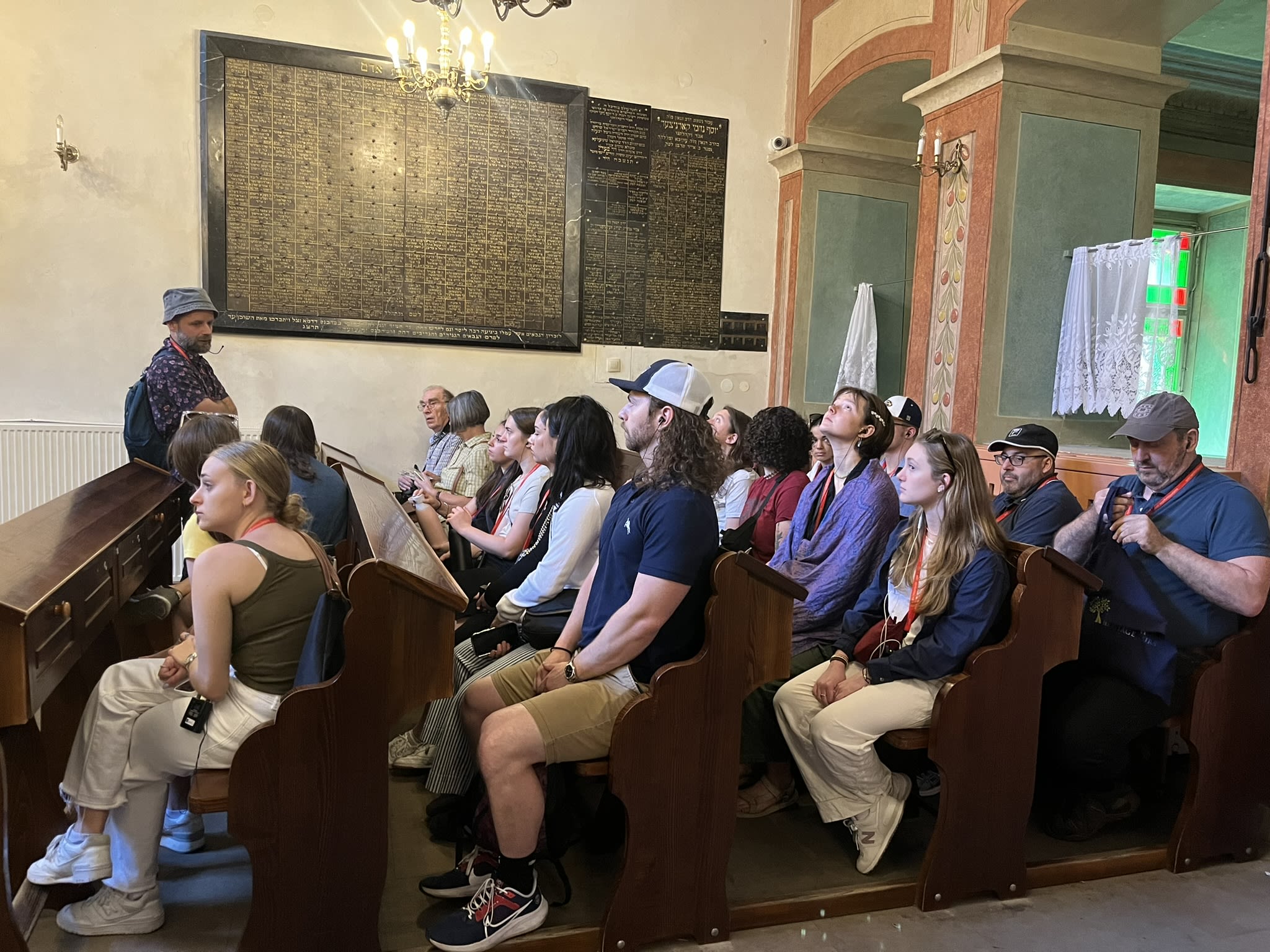



“My favorite aspect of the trip? Meeting other people. It was a chance to practice cultural humility and see from new perspectives.”
“My great-grandfather was a Holocaust survivor, and my grandfather was born in Poland, but I hadn’t been exposed to the culture. What better way to learn my family history?”
“In the Jewish diaspora, there’s a tendency to think of Poland in darker terms, but I experienced the opposite — evidence of robust, thriving Jewish life.”
“In my family, I had heard the tales of the ‘old country.’ I wanted to find out how the contemporary moment engages with the Jewish past. Finding out about this travel, I said, ‘The universe is telling me to go.’”
Country as classroom
Goldstein, associate professor of history and former director of the Tam Institute, shepherded the students between Kraków and Warsaw as well as points in between, from May 19-30.
In the process, he exposed them to Eastern European Jewish life from the 18th century onward; sites such as the former Auschwitz-Birkenau concentration camp, Monument to the Ghetto Heroes and Wielickza Salt Mine; and meetings with Polish and Polish-Jewish activists, university students, and cultural and community leaders.
Before World War II, Eastern Europe was the world’s epicenter of Jewish life with the largest concentration of Jews anywhere until many of those communities were wiped out in the Holocaust.
To make the most of their travel, some students took Goldstein’s spring course Jews of Poland: History and Memory; those who didn’t take the course did readings as preparation.
“The class and readings,” says Goldstein, “were an important analytical tool to prepare students for a trip where they would be asked to think about how history was being presented and how what they observe might be different from conceptions of that history in the U.S., whether in Jewish or popular culture.”
“I also wanted them to be aware that, in Poland today, there are many different ways of remembering the past. There is a politics around how to remember the Holocaust and how to remember the different roles the Polish people played in that event, among other contentious issues,” he adds.
Goldstein started the class with what are known as “memory texts” from the 19th century, a literature that memorialized and idealized traditional Jewish life in small towns — known in Yiddish as “shtetlekh” — just as industrialization was changing it. They read the Tevye story series by Sholem Aleichem that became the basis for “Fiddler on the Roof” as well as accounts of immigrants to the U.S. who had lived in Eastern Europe.
Most important was to have students ask themselves: “When you travel, what cultural work are you doing? We wanted them to think about their role as visitors in a critical way,” Goldstein notes.
An important partner
The Berger Family Fund — established to support student experiential learning on topics related to antisemitism as well as Jewish life and history — allowed the Tam Institute to heavily subsidize the program for students.
One of the students whose participation was enabled by the financial aid earmarked for the trip was Leah Wang, who spoke to what experiencing it firsthand added to her education.
“I learned that history isn’t only through the lens of the Holocaust. In American classes, we sometimes forget the centuries of Jewish history that came before the Holocaust,” Wang says.
Sixteen Emory students, shown against the backdrop of part of the Wawel Castle complex in Old Town Kraków, traveled to Poland to explore how Jewish identity is expressed contemporaneously as well as to contemplate Jewish and Polish history and memory.
Sixteen Emory students, shown against the backdrop of part of the Wawel Castle complex in Old Town Kraków, traveled to Poland to explore how Jewish identity is expressed contemporaneously as well as to contemplate Jewish and Polish history and memory.
Walking through a cemetery in Bochnia and learning to read the symbols on the gravestones unlocked clues to the identities of the Jews interred there.
Walking through a cemetery in Bochnia and learning to read the symbols on the gravestones unlocked clues to the identities of the Jews interred there.
The Medicinal Plants of Płaszów, a workshop conducted on the grounds of the former Płaszów concentration camp, was established to “harness the power of natural healing for social healing” and generated a great deal of student interest.
The Medicinal Plants of Płaszów, a workshop conducted on the grounds of the former Płaszów concentration camp, was established to “harness the power of natural healing for social healing” and generated a great deal of student interest.
“Go go go” — and much new knowledge ensued
Once on the ground in Poland, Becca Wilson laughingly recalls the days as “go go go.” What follows is a partial list of activities.
About 40 miles outside Kraków, the group visited a small town not so different from those they had studied, with the important exception that it has no Jewish residents, which is not an uncommon phenomenon in contemporary Poland. Walking through the marketplace, says Goldstein, “we were able to imagine that, 150 years ago, it would have been teeming with horses, carriages and goods of every kind.”
Just above the town lies a cemetery, all of whose inhabitants are Jewish, with the earliest graves dating to the mid-1800s and extending for the next 100 years. The tombstones bear symbols that Goldstein helped the students decipher. A menorah, for instance, likely meant that the decedent was a woman, given their traditional roles in lighting Shabbat candles. There were symbols for those who had died young as well as veterans, doctors or scholars, such as rabbis. The groundskeeper, who devotes his own resources to the upkeep of the plots, is not a Jew.
After reading a study of the 1948 Monument to the Ghetto Heroes — the first to pay tribute to Jewish resistance to the Nazis — students were able to see it in Warsaw. Commemorating the 50,000 Jews who lost their lives, one side depicts the heroism of the fighters from the Warsaw Ghetto Uprising in April 1943 and, on the other side, the martyrs who died there.
Camp to garden: a remarkable transformation
An experience that intrigued many students was Medicinal Plants of Płaszów, a tour and workshop conducted by members of the FestivALT artistic cooperative on the ruins of the Płaszów concentration camp, the largest Holocaust site in Kraków. After noticing that many medicinal plants and herbs were growing there, ethnobotanist Karol Szurdak proposed “harnessing the power of natural healing for social healing” by creating a garden. Jason Francisco, associate professor of Emory’s Department of Film and Media, had a hand in creating this site in 2018.
Working with Szurdak, Francisco and others collected 18 species of medicinal plants growing at Płaszów — the number corresponding to the Hebrew word for life — and built the garden. “At the opening dedication, the skies opened and rain came to water our garden in what seemed an impossibly poetic moment,” says Francisco.
Ainsley Freedman reflects: “Quite against expectations when one thinks about a concentration camp, this place was full of life. What happened there was horrible, but now what takes place is so wonderful.”
Students were able to harvest some of the plants and create a medicinal balm. “This is literally a case of plants arising from people’s ashes,” says Wang. “The person leading the tour asked us to think about the ethics of the situation, and we did, but we felt good about the medicinal purpose these plants serve and their healing power.”
Zimra Chickering, who majored in nutrition science at Emory and had just completed a botanical medicine course prior to the trip, calls the experience a “full-circle moment. I marveled at so much life and health coming from a place of death. It’s fair to say that I found the site upsetting and hopeful in equal measure.”
Confronting the legacy of Auschwitz-Birkenau
The travelers visited the site of the former Auschwitz-Birkenau concentration camp, which is now both a memorial and museum. The students appreciated the experts Emory provided in advance, cognizant of the weight of what they would experience there.
Goldstein acknowledges, “It is designed to make visitors confront the experience of the prisoners. The cramped quarters. The horrible conditions. The ruins of the crematoria. Of all the things we did, this had the biggest emotional impact on the students.”
“It was powerful to see rooms with artifacts of the camp’s inhabitants. It meant a lot to me to acknowledge that history and offer my own vow of ‘never again,’” says Freedman.
Chickering tried not to harbor expectations. “I wanted to be present, let myself learn and engage with the energy of that space. It wasn’t the easiest experience, but I was grateful for the chance to do it,” she says.
When Wang recounts being there, it prompts fresh tears. “Amid the evidence of so many lives ended there, it was numbing and yet eye-opening to see individuals’ shoes and suitcases,” she says. She found it moving to see Jewish classmates such as Chickering look through the Book of Names for their relatives. Displayed in a permanent exhibition at the museum, it contains 4,300,000 names in English with the date and place of birth as well as murder date, if known.
Wilson noted that the site is commercialized, featuring a gift shop. Yet “I found it hopeful that visitors, speaking so many languages, are coming through there to learn what happened. I previously had been to Yad Vashem during a trip to Israel, so I was prepared. I try to keep my own focus on all that has been done to rebuild Jews’ lives and communities.”
She continues: “As significant as it was for us to learn what this site teaches us, I so appreciated that the trip’s purpose was to help us develop a broader perspective beyond sadness.”
Following the tour, the group gathered at the nearby Auschwitz Jewish Center to rest and process what they had seen. Freedman describes reassurance in being together but acknowledges that they spent the time largely in silence.
The guide who spoke to students the night before the visit cautioned: “You don’t know how long it will take to process the experience.” After the trip, Wang’s mother bought her “The Tattooist of Auschwitz,” the 2018 novel about a Slovakian Jew tasked by the Germans with permanently marking his fellow prisoners.
Reading the novel, “I felt as if I was able to acknowledge the full weight of all I saw. We might not ever be able to fully understand what Holocaust victims endured, but the necessary first step is for us to learn,” Wang says.
Crediting the students’ courage, Goldstein notes: “The site teaches us about the question of evil, genocide and how things like this could possibly happen. It touches us on every level.”
Criss-crossing the country
Students also had the chance to visit the class of Professor Edyta Gawron at Jagiellonian University in Kraków after reading an essay she had written on Jewish studies in Poland.
Chickering was surprised, but impressed, at the class makeup. “The students weren’t necessarily Jewish but still invested in the history because they are Polish. Some had only recently found out they were Jewish because their parents or grandparents had felt it necessary to hide their identities.”
And, after the Polish and American students worked together to analyze a historical text, time was allotted for them to pepper one another with questions about life in their countries.
And then there were the Shabbat dinners, Hillel and Jewish Community Center visits, meals at Jewish restaurants like Ariel. Or visiting the site that inspired the film and book “The Zookeeper’s Wife: A War Story,” about a couple who sheltered Jews fleeing the Warsaw Ghetto on the grounds of the zoo they had been running.
Wilson references a Shabbat dinner at a Jewish Community Center in Kraków. “It came on the heels of our Auschwitz visit. It was powerful to sit in a room full of Jews as a means of showing that we have persevered.”
At a Hillel event in Warsaw, Wang felt the power of community when she was introduced to a medical student who had driven “two hours to join us — two hours to meet strangers.”
Students hear from a guide as they are about to enter the museum and memorial on the site of the former Auschwitz-Birkenau concentration camp.
Students hear from a guide as they are about to enter the museum and memorial on the site of the former Auschwitz-Birkenau concentration camp.
Zachary Mazur, an educator at the POLIN Museum of the History of Polish Jews, led a discussion with Emory students after they explored an exhibit on 1,000 years of Polish-Jewish life.
Zachary Mazur, an educator at the POLIN Museum of the History of Polish Jews, led a discussion with Emory students after they explored an exhibit on 1,000 years of Polish-Jewish life.
Fostering a deeper understanding of the human experience
The travelers acknowledge a debt to Kaja Siczek, the group’s main tour guide, who enlivened every day spent on Polish soil. “She was a wonderful teacher,” says Goldstein.
Siczek grew up in Warsaw not knowing her family was Jewish. When she became aware of her heritage, she attended a Jewish summer camp, became a youth group leader and now works for the Taube Center, with plans to study for the rabbinate in the U.S.
“She is organizing and energizing Jewish life in Poland,” says Goldstein, and Freedman adds: “She was so passionate about showing us her country, which she clearly loves so much.”
The students are grateful to Goldstein as well. Wilson notes, “He was so knowledgeable. At the end of each day, he had great themes for us to ponder and encouraged us to ask additional questions.”
In their final essays, the students addressed what they learned about Jewish life and culture, Poland and the human experience. The result, according to Goldstein, was “poignant and beautiful writing.” Reflections from three of the students, including Wilson, are on the Tam website.
When the busy days abroad ended, what main lesson did the teacher draw from the experience?
“The trip worked on so many different levels,” Goldstein says. “We gained a better, more complex understanding of the Jewish past, but it also became clear that, through the Jewish experience, you can learn about larger human experiences as well.”

